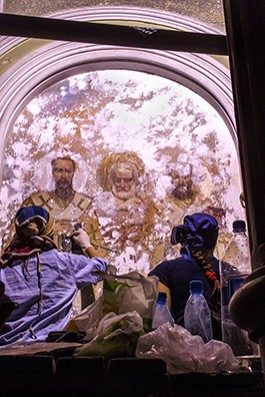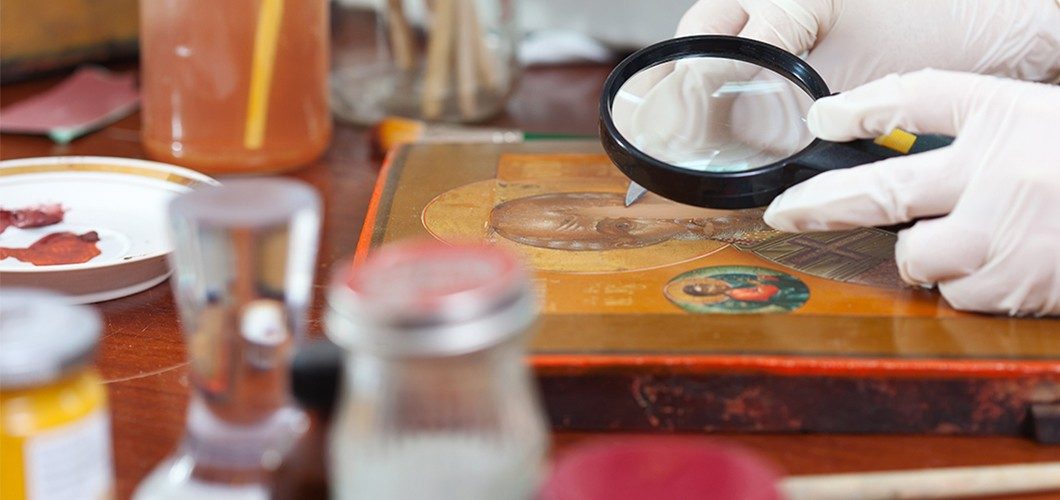Art Conservators Use Cutting-Edge Chemistry to Preserve Masterpieces

Art and chemistry have been linked since the day the first cave dweller smeared mineral pigments on a rock wall. Today’s art conservation chemists (or, conservators) work in a variety of functions to understand, preserve, and repair all types of works of art. As part of their duties, they may document, clean, preserve, and repair works of art. Often, an analysis of the materials used in the artwork and in previous restoration efforts is necessary in order to select or custom-design a restoration method.
Conservators work with irreplaceable objects, many of them very old and fragile. They are often asked to strike a balance between restoring or repairing an object and leaving it “as is” to convey its authenticity and antiquity. Laboratory test samples are often very small, to avoid excessive damage to the object, and nondestructive testing is preferred. Laboratory instruments are sometimes adapted to accommodate very large works of art to avoid having to extract samples.
Other conservators may be responsible for authenticating works of art and other artifacts using laboratory analysis and a knowledge of the materials and methods in use during the relevant period in history.
Career path
In the past, conservators entered their field through a series of apprenticeships. Today, however, it is more common to obtain an academic degree, often at the graduate level. Internships and apprenticeships remain an important part of this education, however. Post-graduate fellowships are also valued for professional development and broadening the conservator’s base of knowledge.
Conservators may start their careers at smaller local and regional establishments, and then move to larger facilities as they gain experience and build their reputations.
Future employment trends
Public interest in science, art, history, and technology will continue to spur demand for curators, museum technicians, and conservators. Because museum attendance is expected to rise over the coming decade, many museums should remain financially healthy and are expected to schedule additional building and renovation projects.
However, competition is intense for the limited number of openings in conservation graduate programs. Conservators should be willing to relocate to fill available openings. The number of museum curators who move to other occupations is relatively low, and they tend to work beyond the typical retirement age of workers in other occupations.
During recessions, museums may experience government funding cuts that limit opportunities. Demand from the private sector may offset some of these cutbacks.
U.S. employment for museum technicians and conservators is expected to rise from 11,900 to 12,700 between 2010 and 2020, an increase of 7%. That increase is about half the predicted growth of 14% for all occupations, but more than the 4% predicted for chemists in general (from 82,200 to 85,400).
Is this career a good fit for you?
Art authenticators and conservators must have good analytical and critical thinking skills, as the objects they deal with present a wide variety of unconventional challenges. They must be meticulous and patient because of the rarity and great value of the objects they deal with. They must have an avid interest in the materials and techniques typical of various periods in history, and they must keep current on advances in technology and methods.
TECHNICAL SKILLS REQUIRED
- Laboratory analysis methods and instrumentation (sometimes customization)
- Computer imaging skills
- Documentation and databases
- Knowledge of historical materials, the time periods during which they were typically used, and their compatibility with contemporary materials
- Mastery of fabrication and conservation techniques
- Materials testing methods
- Knowledge of materials aging, corrosion, weathering, and microbial degradation processes
- Knowledge of health and safety factors and government regulations
- Writing and other communications skills
OPPORTUNITIES
- Competition is intense for the top museum positions. Individual research and publications are important for advancement in larger institutions.
REQUIRED EDUCATION
- A career in art conservation requires a master’s degree in conservation or a closely related field and substantial work experience. Entry to the limited number of graduate programs in the U.S. is very competitive, and requires prior work experience (or an internship or apprenticeship) and an academic background in chemistry, archaeology, studio art, art history, and possibly one or more foreign languages. Graduate programs last 2 to 4 years, which includes internship training.
SALARIES
- Most conservators work full-time. The median annual wage of museum technicians and conservators was $37,310 in May 2010. The lowest 10 percent earned less than $24,440, and the top 10 percent earned more than $68,250. The median annual wage of museum technicians and conservators in the federal government was $38,790. (Median wage for all occupations was $33,840.)




